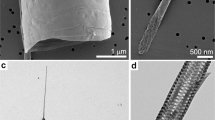Abstract
DIATOMACEOUS earth, as mined in Lompoc, California, and other sites in the south-west United States, is made up of the siliceous skeletons of diatoms which lived in the Miocene and Pliocene periods. The mined diatomite is crushed, blended, pressed into brick and fired at 900° C for use as high temperature insulation. When ground, this material, known as ‘Chromosorb P’ (Johns–Manville Corp.), is sold as a support for the liquid used in the gas chromatographic separation of organic compounds. Some of the diatom skeletons were found to be intact after this rigorous treatment. It has been estimated that as many as 10,000 species of diatoms may be found.
This is a preview of subscription content, access via your institution
Access options
Subscribe to this journal
Receive 51 print issues and online access
$199.00 per year
only $3.90 per issue
Buy this article
- Purchase on SpringerLink
- Instant access to full article PDF
Prices may be subject to local taxes which are calculated during checkout
Similar content being viewed by others
References
Ottenstein, D. M., J. Gas Chrom., 1, 11 (1963); in Advances in Chromatography (edit. by Giddings, J. C., and Keller, R. A.), 3, 137 (Marcel Dekker-Inc., New York, 1966).
‘Stereoscan’ Electron Microscope. B, Operation, Principles and Performance. List 178, Sheet B (Cambridge Instrument Co., London, 1965).
Anon., Electron. Eng., 38, 113 (1966).
Gray, T. R. G., Science, 155, 1668 (1967).
Baker, W. J., Lee, E. H., and Wall, R. F., in Gas Chromatography (edit. by Noebels, H. J., Wall, R. F., and Brenner, N.), 21 (Academic Press, New York, 1961).
Author information
Authors and Affiliations
Rights and permissions
About this article
Cite this article
BENS, E., DREW, C. Diatomaceous Earth: Scanning Electron Microscope of ‘Chromosorb P’. Nature 216, 1046–1048 (1967). https://doi.org/10.1038/2161046a0
Received:
Published:
Issue date:
DOI: https://doi.org/10.1038/2161046a0



